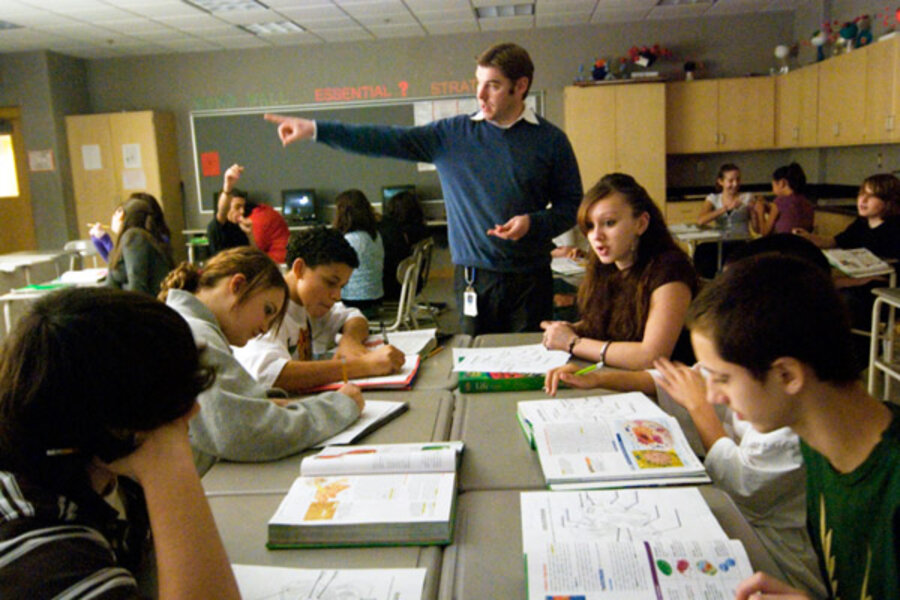Can the US compete if only 32 percent of its students are proficient in math?
Loading...
What do Massachusetts, Switzerland, and Singapore have in common? Their students are among the top performers in the world when it comes to mathematical proficiency.
As for the rest of the United States, the comparison is more bleak, according to a new report: The US ranked 32nd out of 65 countries (or cities such as Shanghai and Hong Kong) that participated in the latest international PISA, an exam administered to representative samples of 15-year-old students by the Organization for Economic Cooperation and Development.
To researchers who authored Wednesday’s report – “Globally Challenged: Are U.S. Students Ready to Compete?” – it’s yet another cause for alarm about the ability of the United States to compete on the global economic scene.
“This is an urgent problem.... We cannot continue to ignore the mathematical education of the next generation if we expect to be a ... highly productive society,” said Paul Peterson, a professor of government at Harvard and co-author of the report, in a live webinar Wednesday morning.
The report draws a link between PISA scores of 10th-graders from 2009 and eighth-grade US math proficiency scores on the 2007 National Assessment of Educational Progress (NAEP), so both samples were drawn from students of the high school graduating class of 2011, in both public and private schools.
Thirty-two percent of students scored “proficient” on NAEP in math. Researchers found the equivalent of what those students would score on the PISA scale and then looked at how many students in other countries performed at or above that level.
In the top-scoring places, such as Shanghai, Korea, and Finland, well over 50 percent of students were proficient in math. The proficiency rate in Massachusetts on PISA was 51 percent. One of the largest states, California, had a rate of just 24 percent and was outranked by 36 countries.
At the bottom end, with less than 20 percent of students proficient, were countries such as Brazil and Indonesia, along with Mississippi and the District of Columbia.
The variability in where the states rank stands out to Michael Shaughnessy, president of the National Council of Teachers of Mathematics (NCTM) in Reston, Va. Part of the problem, he says, is “access and opportunity for kids in math and science – that it’s not a level playing field throughout the country.”
While it won’t be a “quick fix,” Mr. Shaughnessy says, one promising movement to help close those gaps is that 45 states have signed on to new Common Core Standards, which raise expectations in both math and reading and incorporate more skills to ensure that high-schoolers graduate ready for college-level work.
Massachusetts is one of just a few states whose own proficiency standards already are as high as NAEP’s, and its good showing internationally suggests that if all states were able to do what Massachusetts does, the US wouldn’t have a serious problem, Peterson said.
NCTM has been working with educators around the country to change how math is taught – to make it more interactive and keep students’ interest. It also supports efforts to change the cultural attitude in the US “that it’s OK not to be good at mathematics,” Shaughnessy says.
In countries that outrank the US, both math and teaching are generally more respected, and higher stakes are often attached to students’ math abilities (such as whether they will be able to continue their education).
Some critics say such comparisons between countries aren’t particularly useful, especially given the level of ethnic and economic diversity in American schools. But the authors of this report break out statistics to support their view that such diversity doesn’t explain away the poor US ranking.
When looking at the performance of only the white students in the US, for instance, the full samples of students in 16 countries still did better. And US students who have at least one parent with a college degree were outperformed by 13 countries.
The economic stakes of educational improvement have been projected in previous reports by two authors of the current report, Eric Hanushek of the Hoover Institution at Stanford and Ludger Woessmann of the University of Munich. Their work suggests that raising math proficiency rates to the level of Canada or Korea would eventually increase annual GDP growth rates by 30 to 50 percent.
The new report also looks at reading comparisons. The US, with 31 percent of students proficient in reading, ranks 17th. Again, Massachusetts, with 43 percent proficient, is the best-performing state, ranking behind only Shanghai, Korea, Finland, and Hong Kong.





